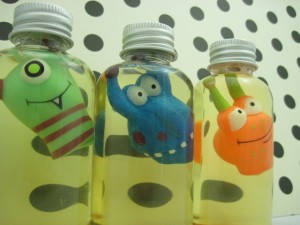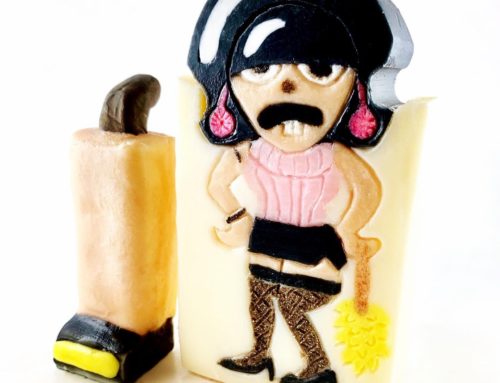
We’re going to start by learning how to formulate a liquid soap recipe.
Let’s start with the ingredients. These are the 5 oils I use most of the time that create a wonderfully thick liquid soap. Let’s talk about each oil and discuss why they are my favorite.
Olive Oil – creates a gentle soap, clear in LS
Safflower Oil – creates a gentle soap, clear in LS, you can sub with sunflower, sweet almond or apricot kernel
Coconut Oil – adds bubbling action to the soap, clear in LS
Castor Oil – creates bubbles, castor is a solvent so it helps with the clarity of LS
Palm Oil – adds body, can cloud soap, can sub with cocoa butter, shea butter, mango butter, lard or tallow
You’ll have a lot of people tell you not to add palm oil, butters and solid fats to LS because it can cloud the soap. I’ve found that if you add 3-7%, especially palm oil, it really does add some body to your soap and helps thicken it up a bit. Using about 6% palm oil in the below recipe I still get pretty clear soap. If I sub shea butter I do get cloudy soap (which I’m okay with!). I make LS with shea butter instead of palm for those who do not want to use a product with palm oil.
Here’s one of my favorite recipes using these oils. The high olive and safflower creates a gentle nourishing soap, the coconut and castor oils add lather, the castor oil acts as a solvent and the palm oil adds body to the finished soap.
Olive Oil – 40%
Safflower Oil – 20%
Coconut Oil – 14%
Castor Oil – 20%
Palm Oil – 6%
We’re going to figure out how much KOH to use by hand. I found that once I started formulating my own recipes and not relying on online lye calculators I became much more successful making liquid soap. Unfortunately there are just too many variances between all of the online calculators and it just gets to be confusing. So to do this you’ll need to get the KOH SAP values for your oils. I use the list from Soapers Choice you can find here… http://soaperschoice.com/products_list.php.
You’ll see values for both KOH (liquid soap) and NaOH (solid soap). Be sure to use the KOH values. You’ll notice also that these are higher; it takes more KOH than NaOH for any given oil to saponify. Multiply the KOH value by the amount of oil in your recipe. Let’s use grams so we can be as accurate as possible.
KOH Value Our Recipe KOH needed to saponify oil
Olive Oil – 40% .19 350 g 66.5 g
Safflower Oil – 20% .19 170 g 32.3 g
Coconut Oil – 14% .256 115 g 29.44 g
Castor Oil – 20% .18 170 g 30.6 g
Palm Oil – 6% .203 50 g 10.15 g
Add up your KOH and this is the total amount of KOH needed to saponify your oils. We end up with 168.99 so let’s round it to 168 g.
We need to take it into consideration that KOH is not 100% pure KOH. It contains about 8-12% “other” stuff- mostly water. If you’ve read Failor’s book, Making Liquid Soap, you’ll notice that she uses a 10% lye excess in her calculations. I like using 8%.
There is much discussion on superfatting or using a lye excess in liquid soap making. If you use a lye excess you’ll need to bring the PH down a bit but if you superfat you’ll run the risk of cloudy soap (not a big deal) or soap that separates or has a layer of unsaponified oil floating on top (this is a big deal to me).
I choose to use a lye excess because I want all of my oils/fats as close to 100% saponified as possible. I don’t want any sort of floating layer of soap/oils and I reduce the risk of any type of rancidity setting in especially since I use Safflower oil. Free fatty acids go rancid so if all of the oils are saponified; there aren’t free oils to go rancid.
From our calculations above we end up with 168 g KOH. We want to add a lye excess of 8% to this. So we multiply 168 x .08 (8%) to get 13.44. Add 168 to 13.44 and we get 181.44. I’m going to go ahead and round down to 181 g.
You’ll have two phases of water for your liquid soap.
1. The initial water for the paste
2. The water needed for dilution (we’ll discuss later)
To find the water needed for the paste multiply the KOH amount by three. So we’ll end up with 543 g of water. So here is what we’ll need to make our soap paste.
Olive Oil – 350 g
Safflower Oil – 170 g
Coconut Oil – 115 g
Castor Oil – 170 g
Palm Oil – 50 g
KOH 181 g
Distilled Water 543 g
We end up with a paste that is about 55oz. (Give or take – there will be slight water evaporation.)
This is simply our paste. We’ll discuss more of the process in a bit.
Amanda






Great post! I love making liquid soaps too.
Thank you! You make it look easy 🙂
Gerti
Thanks for this lesson….you make it sound really do-able! I will try to make some LS for Christmas presents!